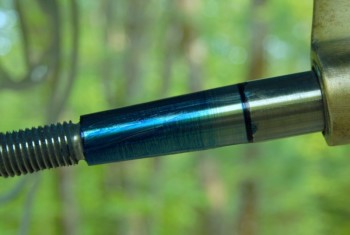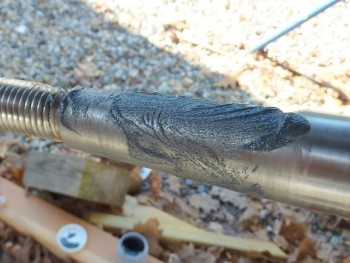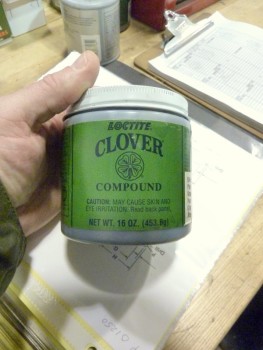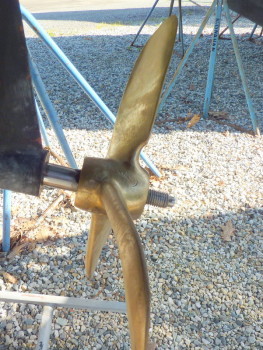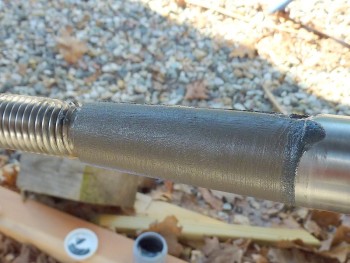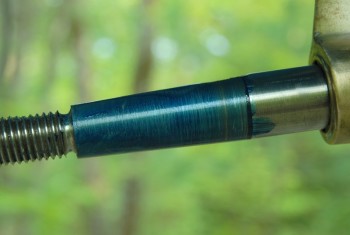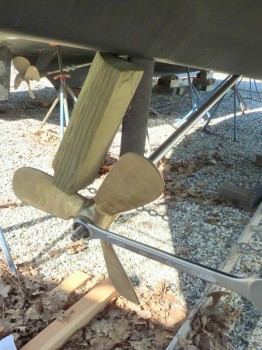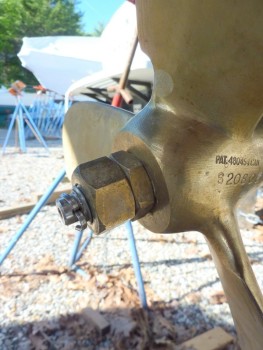Slide The Prop On The Taper
Step 1 – The first step is to slide the prop, or prop hub, onto the shaft without the key. Be sure the shaft & prop hub are clean. Once it’s been slid into place, and seated as deeply as it will go, mark around the leading edge with a Sharpie marker, as seen in this photo.
Coat the Taper With Prussian Blue
Step 2 – You’ll want to have some Prussian Blue on hand to coat the shaft taper with. You can buy it at NAPA and it costs about $3.00. A small tube goes a long way. You don’t need a ton of it but it also doesn’t like to coat evenly so you may have some low spots and thick spots which are not a huge deal.
Slide The Prop/Hub Onto The Shaft Again
Step 3 – Slide the prop or hub back onto the shaft again and seat it like you did when making the mark. Once seated, lock the shaft and spin the hub around it about five-ten times and remove the hub or prop.
There are a number of techniques to using Prussian Blue, I find this one works well but some prefer other methods. The only critical thing is that your method results in a good fit.
In this photo you can see a clean area at the leading edge of the taper where the Prussian Blue has been wiped off. This clean area is the only area this new prop and shaft made good contact. This represents less than 15% contact and even with the prop nuts tight you might have only ever see approx 20% contact. This can lead to point-loading of the shaft and a possible shaft fracture. With improperly fit propellers shafting fractures are not as uncommon as one may think they are. If the shaft fails you not only loose the shaft but may also loose a multi-thousand dollar propeller too.
This shaft was brand new and made by a shop that does military shafting and has the calibrated dies to test the taper. Not all shops have or use these calibrated test dies and they are normally only used to make sure the machines are in tolerance. This taper was tested, with Blue, and was spot on. That leaves the Flex-O-Fold prop taper as the likely culprit here.
This type of poor fit is not uncommon. The sad part is that many boat yards never even bother to check the fit and instead just slap the prop on. Fits like this are common because machines wear and differ slightly. The prop was machined at one shop, in another country, and the shaft at another.
Apply Compound to Shaft
Step 4 – Remove the key and apply a liberal amount of valve grinding compound to the shaft and slather the area where the prop will sit.
The process of lap-fitting your prop to the prop shaft taper makes certain both the shaft and prop mate together on the taper well leaving no high or low spots. By lap-fitting you achieve the maximum shaft to prop mating surface area.
When you see the inside of a prop with rings or high and low spots it was not reamed or lap fit properly. The mating of the two surfaces is actually very simple to do. They fit to each other through the act of rotating the prop around a locked shaft with the valve grinding compound, essentially liquid sandpaper, in-between the two surfaces. The idea to to achieve at least a 70%+ contact area or better during this process. You can further check your work with Prussian Blue but it’s not totally necessary.
Ideally, this should be done any time you replace a shaft or prop and are mating a new prop to an old shaft or if you are unsure whether it has ever been done.
You do not want to over do this though.
Valve Grinding Compound
The compound you use for this task is commonly referred to as valve grinding compound. I’ve used Clover Compound by Loctite and also the compound by Permatex which is available at most any NAPA Auto.
For this task I do prefer the oil lubricated valve grinding compounds as opposed to the water based versions. With the water based product the prop seems to bind more and is grabby when rotating it around the shaft.
For this pictorial I used oil based Permatex brand but any fine valve grinding compound will work.
Slide The Prop Onto The Shaft
Step 5 – Once you’ve applied the compound to the shaft, slide the prop onto the shaft but do not drive it on hard. Once it feels seated and is not wobbling on the shaft begin to rotate the prop around the shaft. Rotate the prop about 5 – 10 times then remove it and inspect the mating surfaces. Repeat as is necessary.
TIP: It helps if you have locked the gear box into gear.
After Lap Fitting
Here is what it looks like after rotating and before wiping the valve grinding compound off the shaft. The picture with the compound wiped off came out all blurry so I’ll need to take another one at some point.
NOTE: The prop is the part that will give up more material as it is significantly softer than most shafting unless you have an old bronze shaft.
The shaft and inside of the prop should look evenly ground with no spots that have not been honed.
After 20 Turns
This article is a conglomeration of two different installs because the Prussian Blue pics came out blurry on the Campbell Sailor shoot. Either way this is what it will begin to look like after lap fitting.
The Prussian Blue should be evenly distributed when done. Be sure to use some forward pressure on the prop when spinning it on the Prussian Blue. This one still needs a little more but not much.
When sliding the prop off of the Prussian Blue use a quick straight back pull, no spinning, and try not to drag it along the shaft as you can make a mess if your new evidence. You will invariably have some drag marks but you want as much fit evidence left on the shaft as possible.
When all was said and done with the Flex-O-Fold & Campbell Sailor there was better than 90% contact between prop & shaft.
The entire process takes about 15 minutes to fit a prop to the shaft.
High & Low Spots
In this photo you will notice a couple of either high or low spots about half way down the inside of the prop & the concentric rings I was talking about.
This prop was worse before I started but the shots down through the bore never came out good enough to publish (note to self; remember to bring flash).
This photo was taken after about five rotations. I spun it a total of 22 rotations and these high & low spots were no longer visible making for a much better fit interface.
Clean The Prop & Shaft
Step 7 – To clean the inside of the prop I use a terry cloth towel doused in denatured alcohol. Simply pull it through the prop a few times and you will be ready to install it.
Always check the key-way to ensure that all the grinding compound is out of the it as well. If you can’t get it clean with a rag you can use a Q-Tip to clean the key-way.
Install The Propeller
Step 8 – To install the propeller you’ll want to follow these simple steps:
1- Slide the prop onto the shaft, without the key, until it will not move any further.
2- Mark the leading edge of the prop where it meets the shaft with a fine tip Sharpie marker. This is your insert-depth mark. When installed with the key, and torqued down, you should no longer see the fine point Sharpie marking.
3- Install the key and slide the prop over it and up the shaft. If you can’t get to your mark the key is key-bound and the prop & key needs to be readjusted.
4- Thread on the big nut and insert a block of wood between the hull and prop to lock it.
5- Torque the large nut preferably using the correct sized wrench. These nuts are soft and can be rounded easily so a proper fitting wrench is a very good idea. The nuts for a 1″ shaft are usually, but not always, 1 1/4″.
6- Once the prop has been torqued down remove the large nut and replace it with the thinner nut and torque it down.
7- To properly torque the prop nut you may need a block of wood between the hull & prop. Please use extreme caution doing this with a folding or feathering prop, in fact, try NOT to. Even older fixed blade props that have been re-pitched can be too soft for this approach. Always use the wood as close to the hub root as you can get.
The best method for torquing the nut is to use a high quality strap wrench on the shaft instead of a block of wood but you’ll want a decent one as the cheap ones tend to slip on small diameter shafts.
Install the Prop Shaft Nuts
Step 9 – Yes, the small nut is supposed to go on first acting like a lock-washer, with the big nut backing it up. I always torque with the big nut then flip-flop them and lock them onto each other with two wrenches.
Once the nuts are on and torqued install your cotter pin. I have found that if I don’t really bend over the cotter-pin that it can hook weeds. Ideally you don’t want to bend them that much, but figure out what works for your local waters.
Good luck & happy boating!



